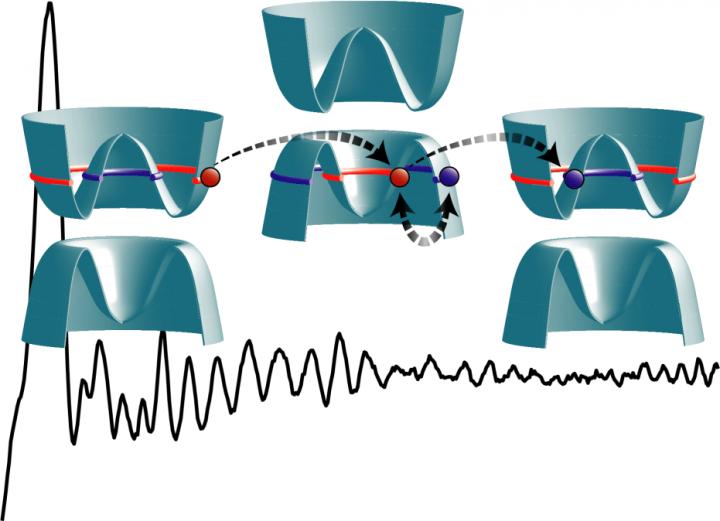A new path for electron optics in solid-state systems

Schematic of the electron–hole interference: Electron-like (blue) and hole-like (red) states coexisting in a double quantum well can interfere if the system is suitably biased. Image: ETH Zurich/D-PHYS Zilberberg group
Electrons can interfere in the same manner as water, acoustical or light waves do. When exploited in solid-state materials, such effects promise novel functionality for electronic devices, in which elements such as interferometers, lenses or collimators could be integrated for controlling electrons at the scale of mirco- and nanometres.
However, so far such effects have been demonstrated mainly in one-dimensional devices, for example in nanotubes, or under specific conditions in two-dimensional graphene devices.
Writing in Physical Review X, a collaboration including the Department of Physics groups of Klaus Ensslin, Thomas Ihn and Werner Wegscheider in the Laboratory for Solid State Physics and Oded Zilberberg at the Institute of Theoretical Physics, now introduces a novel general scenario for realizing electron optics in two dimensions.
The main functional principle of optical interferometers is the interference of monochromatic waves that propagate in the same direction.
In such interferometers, the interference can be observed as a periodic oscillation of the transmitted intensity on varying the wavelength of the light.
However, the period of the interference pattern strongly depends on the incident angle of the light, and, as a result, the interference pattern is averaged out if light is sent through the interferometer at all possible incident angles at once.
The same arguments apply to the interference of matter waves as described by quantum mechanics, and in particular to interferometers in which electrons interfere.
As part of their PhD projects, experimentalist Matija Karalic and theorist Antonio Štrkalj have investigated the phenomenon of electronic interference in a solid-state system consisting of two coupled semiconductor layers, InAs and GaSb.
They discovered that the band inversion and hybridization present in this system provide a novel transport mechanism that guarantees non-vanishing interference even when all angles of incidence occur.
Through a combination of transport measurements and theoretical modelling, they found that their devices operate as a Fabry-Pérot interferometer in which electrons and holes form hybrid states and interfere.
The significance of these results goes firmly beyond the specific InAs/GaSb realization explored in this work, as the reported mechanism requires solely the two ingredients of band inversion and hybridization. Therefore new paths are now open for engineering electron-optical phenomena in a broad variety of materials.
Media Contact
All latest news from the category: Physics and Astronomy
This area deals with the fundamental laws and building blocks of nature and how they interact, the properties and the behavior of matter, and research into space and time and their structures.
innovations-report provides in-depth reports and articles on subjects such as astrophysics, laser technologies, nuclear, quantum, particle and solid-state physics, nanotechnologies, planetary research and findings (Mars, Venus) and developments related to the Hubble Telescope.
Newest articles

Sea slugs inspire highly stretchable biomedical sensor
USC Viterbi School of Engineering researcher Hangbo Zhao presents findings on highly stretchable and customizable microneedles for application in fields including neuroscience, tissue engineering, and wearable bioelectronics. The revolution in…

Twisting and binding matter waves with photons in a cavity
Precisely measuring the energy states of individual atoms has been a historical challenge for physicists due to atomic recoil. When an atom interacts with a photon, the atom “recoils” in…

Nanotubes, nanoparticles, and antibodies detect tiny amounts of fentanyl
New sensor is six orders of magnitude more sensitive than the next best thing. A research team at Pitt led by Alexander Star, a chemistry professor in the Kenneth P. Dietrich…





















